Total eclipse of Blood Moon on night of October 7-8
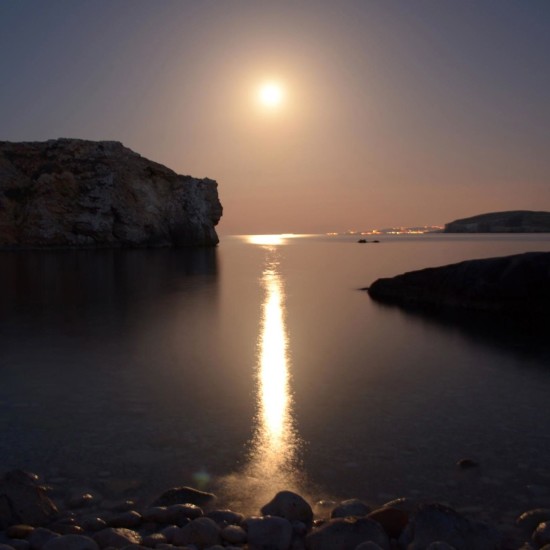
Tonight for October 7, 2014
When is the October 2014 moon exactly full?
Who will see the October 7-8 total lunar eclipse?
Who will see the partial lunar eclipse on October 8?
Eclipse times in Universal Time.
Eclipse times for North American time zones.
Lunar eclipse computer courtesy of the US Naval Observatory
Eclipse calculator courtesy of TimeandDate
A double Blood Moon eclipse on October 8?
How is the Hunter’s Moon different from other full moons?
EarthSky lunar calendars make perfect gifts for all ages!
Day and night sides of Earth at instant of the October 2014 full moon
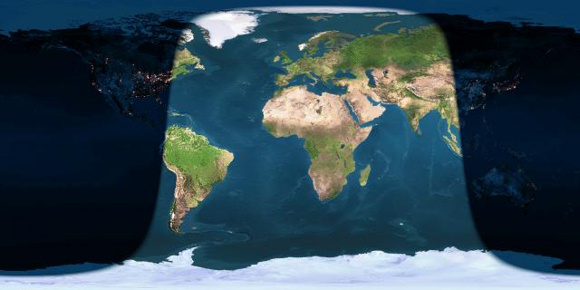
Day and night sides of Earth at instant of the October 2014 full moon (2014 October 8 at 10:51 Universal Time)
But to astronomers, the moon turns full at a well-defined instant: when it’s most opposite the sun for the month.
That instant happens on October 8, 2014 at 10:51 UTC. At our U.S. time zones, that places the precise time of full moon on October 8 at 6:51 a.m. EDT, 5:51 a.m CDT, 4:51 a.m. MDT or 3:51 a.m. PDT. At that time, because there’s an eclipse happening, the moon will be totally submerged in the Earth’s dark umbral shadow.
Meanwhile, because of the difference in time zones, this same full moon happens at local midnight (October 7-8) for far-western Alaska and the Aleutian Islands. It’s sunrise (October 8) for northeastern North America and far-western South America, and it’s sunset (October 8) in Asia.
Watch the full-looking moon on the night of October 7-8 rise in the east as the sun goes down. Like any full moon, the Hunter’s Moon will shine all night long. It’ll soar highest in the sky around midnight and will set in the west around sunrise.
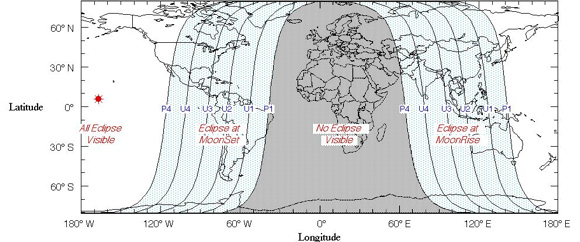
View larger. Worldwide eclipse map courtesy of NASA Eclipse Web Site.
North and South America, the Pacific Ocean, New Zealand, Australia and eastern Asia are in a good position worldwide to watch the total eclipse of the moon on October 8. If you live in the Americas or Hawaii, the total eclipse happens before sunrise October 8. In the world’s eastern hemisphere, the total eclipse happens after sunset October 8.
A very light penumbral eclipse comes before and after the dark (umbral) stage of the lunar eclipse. But this sort of eclipse is so faint that many people won’t even notice it. The penumbral eclipse would be more fun to watch from the moon, where it would be seen as a partial eclipse of the sun.
Who will see the partial lunar eclipse on October 8? A partial lunar eclipse may be visible in the haze of morning dawn from the extreme eastern portion of North America (Newfoundland), before sunrise on October 8. A partial lunar eclipse can also be observed from western Asia (eastern India, Nepal, western China) after sunset on October 8.
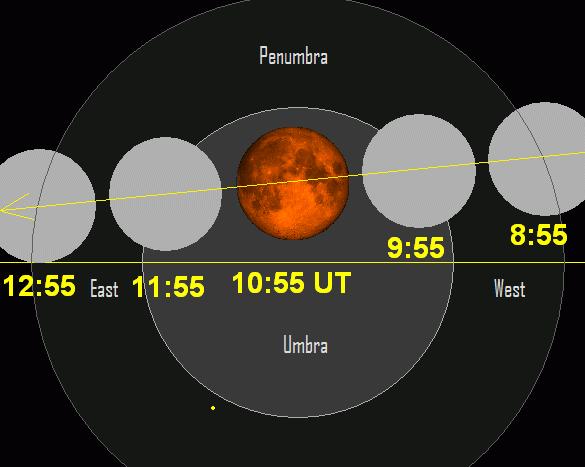
The moon moves from west to east across the Earth’s shadow. The horizontal yellow line depicts the ecliptic
– Earth’s orbital plane projected onto the dome of sky. The greatest
eclipse takes place on October 8, at 10:55 Universal Time (6:55 a.m.
EDT, 5:55 a.m. CDT, 4:55 a.m. MDT or 3:55 a.m. PDT). Click for eclipse computer
Partial umbral eclipse begins: 9:15 Universal Time (UT)
Total eclipse begins: 10:25 UT
Greatest eclipse: 10:55 UT
Total eclipse ends: 11:24 UT
Partial umbral eclipse ends: 12:34 UT
How do I translate Universal Time to my time?
Eclipse times for North American time zones.
Eastern Daylight Time (October 8, 2014)
Partial umbral eclipse begins: 5:15 a.m. EDT on October 8
Total eclipse begins: 6:25 a.m. EDT
Greatest eclipse: 6:55 a.m. EDT
Total eclipse ends: 7:24 a.m. EDT
Partial eclipse ends: 8:34 a.m. EDT
Central Daylight Time (October 8, 2014)
Partial umbral eclipse begins: 4:15 a.m. CDT on October 8
Total eclipse begins: 5:25 a.m. CDT
Greatest eclipse: 5:55 a.m. CDT
Total eclipse ends: 6:24 a.m. CDT
Partial eclipse ends: 7:34 a.m. CDT
Mountain Daylight Time (October 8, 2014)
Partial umbral eclipse begins: 3:15 a.m. MDT on October 8
Total eclipse begins: 4:25 a.m. MDT on October 8
Greatest eclipse: 4:55 a.m. EDT
Total eclipse ends: 5:24 a.m. EDT
Partial eclipse ends: 6:34 a.m. EDT
Pacific Daylight Time (October 8, 2014)
Partial umbral eclipse begins: 2:15 a.m. PDT on October 8
Total eclipse begins: 3:25 a.m. PDT
Greatest eclipse: 3:55 a.m. PDT
Total eclipse ends: 4:24 a.m. PDT
Partial eclipse ends: 5:34 a.m. PDT
Alaskan Daylight Time (October 8, 2014)
Partial umbral eclipse begins: 1:15 a.m. ADT on October 8
Total eclipse begins: 2:25 a.m. ADT
Greatest eclipse: 2:55 a.m. ADT
Total eclipse ends: 3:24 a.m. ADT
Partial eclipse ends: 4:34 a.m. ADT
Hawaii-Aleutian Standard Time (October 7-8, 2014)
Partial umbral eclipse begins: 11:15 p.m. HAST on October 7
Total eclipse begins: 12:25 a.m. HAST on October 8
Greatest eclipse: 12:55 a.m. HAST on October 8
Total eclipse ends: 1:24 a.m. HAST on October 8
Partial eclipse ends: 2:34 a.m. HAST on October 8
A double Blood Moon eclipse on October 8? Okay, we’re saying this a bit tongue in cheek, but somebody is bound to come up with this. In skylore, the Northern Hemisphere’s Hunter’s Moon on October 7-8 will be called a Blood Moon. Plus the October 7-8 total lunar eclipse – the second of four total lunar eclipses in the ongoing lunar tetrad – has been widely called a Blood Moon. Voila. Double Blood Moon.
Hunter’s Moon is just a name. It’s the name for the full moon after the Harvest Moon, which is the full moon nearest the September 23 autumnal equinox. This year, the Harvest Moon came on September 9. That’s why tonight’s moon bears the name Hunter’s Moon.
Blood Moon is just a name, too. It’s one of dozens, maybe hundreds, of full moon names that spring from skylore, a form of folklore centered on the sky. Read about some full moon names here.
In 2014 and 2015, a new usage of the term Blood Moon sprang up. Surely you heard about it at the total lunar eclipse in April 2014. It’s the name being used for the four eclipses of the ongoing lunar tetrad – four total lunar eclipses in a row, each separated from the other by six lunar months (six full moons). Read about the lunar tetrad and about this sort of Blood Moon, here.
Meanwhile, this moon is the Southern Hemisphere’s first full moon of spring. The September 23 equinox ushers in the spring equinox in the southern half of the globe.
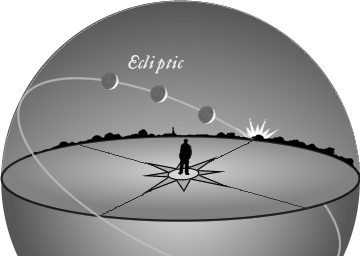
In
autumn, the angle of the ecliptic – or sun and moon’s path – makes a
narrow angle with the horizon. Image via classicalastronomy.com.

The
narrow angle of the ecliptic means the moon rises noticeably farther
north on the horizon, from one night to the next. So there is no long
period of darkness between sunset and moonrise. Image via
classicalastronomy.com.
Autumn full moons – like the Hunter’s Moon or Harvest Moon – are different from other full moons. That’s because, in autumn, the ecliptic – or path of the sun, moon and planets – makes a narrow angle with the evening horizon. That fact causes several sky phenomena. For example, the location of the moonrise on your horizon, for several nights around a Northern Hemisphere autumn full moon, is noticeably farther north along the eastern horizon for several nights in succession.
It’s this northward movement of the moon along the eastern horizon at moonrise – for several days in a row, around the time of full moon – that gives the Hunter’s Moon its magic.
These more northerly moonrises assure us of earlier-than-usual moonrises around the time of full moon. On average, the moon rises 50 minutes later daily. But at mid-northern latitudes around now, the moon is rising about 30 to 35 minutes later. And farther north, the effect is even more pronounced. For instance, at latitudes close to the Arctic Circle – like at Fairbanks, Alaska – the moon actually rises around 15 to 20 minutes later for several days in a row.
Meanwhile, in the months of September, October and November as seen from the Southern Hemisphere, it’s springtime. In the spring, there is a particularly long time between successive moonrises, around the time of full moon.
Before the advent of electricity, our ancestors knew how to plan nocturnal activity around the full Hunter’s Moon. If you live sufficiently north on the globe, you can count on tonight’s Hunter’s Moon to bring early evening-till-dawn moonlight for the next several nights!
As autumn full moons, the Harvest and Hunter’s Moons show this seasonal effect, though to a lesser extent than usual around now due to an effect known as minor lunar standstill.
Read more: Lunar standstill cycle lessens impact of Hunter’s Moons
Bottom line: The 2014 Hunter’s Moon takes place on the night of October 7-8 for us in the western hemisphere and on the evening of October 8 for the eastern hemisphere. In skylore, the Hunter’s Moon is the full moon after the Harvest Moon, which is the full moon closest to the September equinox. It’s characterized by a shorter-than-usual time between moonrises for several nights in a row around full moon. This 2014 Hunter’s Moon features the second of four total lunar eclipses in the ongoing lunar tetrad. Thus this eclipse will be called a Blood Moon.
Photo top of post by EarthSky Facebook friend John Michael Mizzi on the island of Gozo
What is a Blood Moon?
A planisphere is virtually indispensable for beginning stargazers. Order your EarthSky planisphere today.
See it! Photos of total lunar eclipse of April 14-15

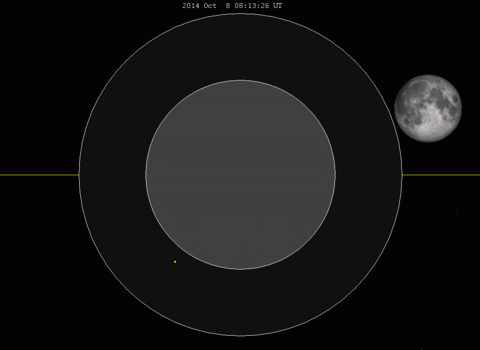
No comments:
Post a Comment